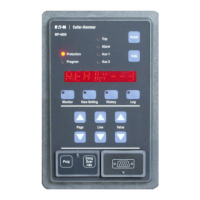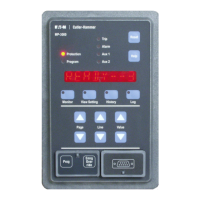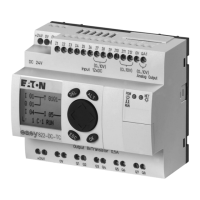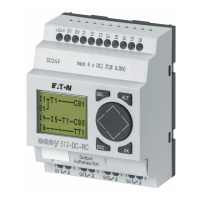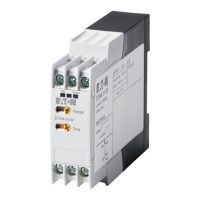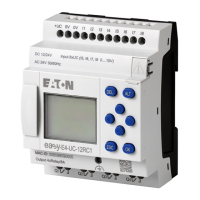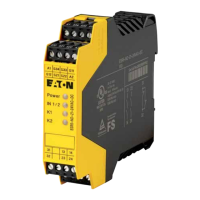IM02602002E
www.eaton.com Page 9-3
MP-3000
switches the starter from reduced to normal running voltage. Refer to
Subsection 9.2.1. The User might elect to transition on time (e.g., set
P5L7 to TRN TIME and P5L6, TRNT=10 seconds) or on current (e.g.
set P5L7 to TRN I and P5L5, TRNC to 130 % of FLA), among other
options.
Figure 9.5 shows the impact of a stator RTD measurement. Look at
the time period after 60 seconds (near the top). When RTDs report
low stator temperature, the motor can run continuously with current
well above (to the right of) the UTC line. The lower the stator tempera-
ture, the higher the acceptable sustained current moves beyond UTC
(200% of FLA in the example). A hotter stator, perhaps caused by a
high ambient temperature or a cooling blockage, shifts the curve to
the left and lowers the acceptable level of I
2
t. Be sure to set a suitable
RTD temperature trip value (WD T) according to Subsection 9.1.8.
An OFF setting causes the MP-3000 relay to revert to the non-RTD
algorithm, even if RTDs are connected.
In some applications, the MP-3000 can forestall a jam alarm or trip, or
a thermal trip, by sending a signal to the process to reduce loading.
The load-shedding function, if enabled, closes or opens the AUX1
contact to shed process load when the motor load current goes above
the load-shed threshold LSPU, P9L1, for a time exceeding the load-
shed run delay LSDL, P9L3. This could, for example, be connected
to stop ow of material into the driven process until the load current
drops below the load-shed dropout threshold LSDO, P9L2 for time
LSDL, P9L3.
Set the load-shed pickup current LSPU, P9L1 comfortably below the
jam trip level. It may be useful to set it below UTC, P1L4, particularly
if RTDs are not used. Refer to Section 5 for an explanation of P9L1
to P9L3, and for imposed relationship rules on load shedding pickup,
dropout, and time delay settings.
The User can temporarily defeat the I
2
t thermal protection limit after
a start by setting a Long Acceleration Time delay (LAT, P5L10). This
can be a dangerous setting that blocks thermal tripping and holds the
bucket at a 100% level if the load takes a long time to reach running
speed. An example is a motor spinning a large centrifuge. In using
LAT, the User can take advantage of the partial cooling from airow
produced by motor spinning at below-normal speed, as compared to
unfanned heating of a locked rotor. The motor must be rated for this
severe starting duty. Also, the User must ensure that the motor actu-
ally has begun to spin well before the locked-rotor time has expired.
This is accomplished by connecting a zero-speed switch to Discrete
Input 1 and setting P5L11 ZSW = ON. The zero-speed switch is a
contact that is closed when the motor is at rest, and opens as the mo-
tor begins to spin, usually at 5-10% of running speed. If ZSW is set to
ON and the MP-3000 does not sense the contact open in one-half the
locked-rotor time setting, it trips the motor.
-
-
If LAT is used, check the settings of transition time TRNT, P5L6 and
jam start delay JMSD, P3L7 to be sure they are coordinated with the
prolonged starting cycle.
If the MP-3000 is communicating with an Eaton PowerNet host
computer, the User can upload the actual time history of the starting
current from the moment of a particular start to a time well past the set
locked-rotor time. The actual current-versus-time prole can be visu-
ally checked against the cold-start protection curve, which PowerNet
plots for comparison. The PowerNet plot also includes the long-ac-
celeration extension of the thermal curve, and the jam trip limit. The
proled starting current is the average rms phase current.
The MP-3000 stores the last four starting current proles. This prole
data cannot be read on the front panel display.
The effects of the motor winding temperature alarm and trip (P2L2
and P2L3) settings, which can be used with RTDs, are not shown in
Figure 9.5. These direct temperature functions protect independently
of the I
2
t algorithm. For the thermal algorithm to take advantage of the
stator RTDs, the thermal direct tripping must be turned on by setting a
suitable temperature for trip, not OFF. The settings for these functions
should be based on the recommended maximum stator insulation
temperature, as indicated by the motor manufacturer’s insulation clas-
sication on the nameplate. The RS-232 setpoint must be disables to
communicate with the URTD.
Class A B F H
Ambient Temperature °C/°F 40/104 40/104 40/104 40/104
Allowable Rise °C/°F 60/140 80/176 105/221 125/257
Hot Spot Allowance °C/°F 5/41 10/50 10/50 15/59
Hot Spot Temperature °C/°F 105/221 130/266 155/311 180/356
Rising winding temperature has to travel through the insula-
tion and stator iron to heat the RTD. When setting the stator
temperature alarm and direct thermal trip temperatures, keep
in mind that the actual hottest-spot insulation temperature may
be 5 to 15°C (41 to 59°F) above the hottest RTD measure-
ment. This additional temperature rise above the insulation
rating may cause the insulation to age twice as quickly as it
would if kept within the rating. Set the thermal trip temperature
a little below the insulation rating for longest motor life.
Unbalanced or negative sequence currents are usually caused by
unbalanced supply voltage. Certain harmonics, such as 5
th
and 11
th
,
also cause the same undesirable effects in the motor even though the
harmonics are balanced.
The thermal algorithm incorporates the accentuated heating effect
of negative sequence currents or these certain harmonics, and trips
more rapidly for unbalanced conditions than would be expected from
the cold-start balanced protection curve.
In addition to the thermal algorithm, the MP-3000 includes a percent
unbalance function that alarms and/or trips based on direct measure-
ment of unbalance. This can be used to speed up tripping and avoid
motor heating for a gross problem, such as depressed voltage on one
phase, loss of a phase, or an uncleared power-system fault external to
the protected motor.

